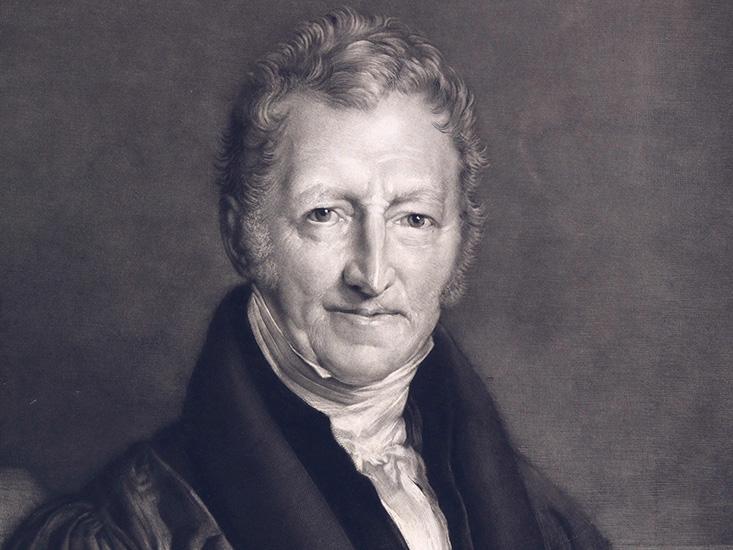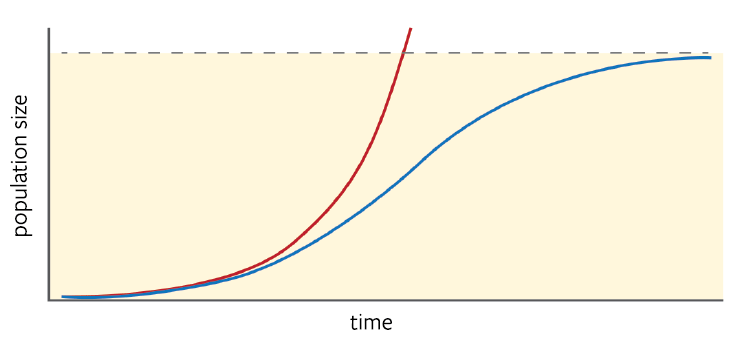For several centuries, we have predicted restrictions on the number of people, and then we beat these records

To say that
Thomas Malthus was unpopular would be too soft. His 19th century contemporary,
Percy Shelley , a respected poet, called him a eunuch and a tyrant.
William Godwin , the philosopher and father-in-law of the poet, called Malthus "a dark and terrible genius, always ready to destroy all the hopes of humanity" [
his daughter Mary Shelley invented Frankenstein and his monster - approx. trans. ]. As the biographer of Malthus later wrote, he was the most abused man of his century. Considering that this was the century of Napoleon Bonaparte.
The catalyst of the persecution was the publication in 1798 of the book "Essay on the law on population". In it, Malthus, the curly 32-year-old vicar of a small English chapel, criticized utopians such as Godwin, who believed that reason and scientific progress would lead to the emergence of an ideal society free from inequality and suffering. Malthus was more pessimistic. Using the census data collected in the United States by Benjamin Franklin, he predicted that “sexual passion” would soon cause the human population to exceed the limits of its resources, leading to poverty and other difficulties. Without control, people will multiply exponentially quickly and their number will double every 25 years. At the same time, agricultural yields will grow at best linearly, by the same amount per year. After 100 years in Britain there will be 16 times more mouths (112 million), but less than 50% of the required amount of food.
This, of course, did not happen. By 1900, the British population had increased only five times, to 35 million people, most of whom did not starve [the author modestly kept silent about the
great Irish famine , which killed up to 1.5 million Irish people, and emigrated as many more from the country - approx. trans.]. But Malthus foresaw the slowdown in population growth. According to him, to prevent excessive growth and death of the population - the infamous "
Malthusian catastrophe " - nature has two types of checks. “Preventive” checks reduce fertility: in difficult times and in the absence of food, men will be able to foresee future difficulties, and postpone marriage and family life. “Positive” checks — hunger, disease, murder, war — increase mortality. As soon as food production catches up with demand, the rivalry subsides and families grow. Thus, the “oppressive law of need, suffering and fear of suffering” causes the number of people to synchronously fluctuate in the area of food supply. To the disgust of his critics, Malthus used this theory to criticize English laws aimed at supporting needy families, the size of which corresponded to the number of children. Why encourage the poor to multiply, said Malthus, if Nature itself crushes them?

However, Malthus looked at one important catch. If nature makes us live within our means, then Malthus seriously underestimated our ability to increase these funds. By the time of his death in 1834, there was an agricultural revolution in Europe. Farmers learned to grow more meaty and fast-growing cattle, and planted crops to replenish the amount of nitrogen in the depleted soil. Together with the industrial revolution came coal-working plows and threshers. In the middle of the 20th century, the green revolution produced seeds with high productivity and synthetic fertilizers. Between 1900 and 2000, contrary to the gloomy forecast of Malthus, the population of the planet quadrupled, from 1.6 to 6.1 billion. Grain production increased fivefold, from 400 million to 1.9 billion tons.
Apart from some local manifestations of hunger, humanity has so far managed to escape the Malthusian fate. The earth now supports the lives of 7.3 billion people, and according to a UN report, this number will rise to 9.7 billion by 2050, and to 11.2 billion by the end of the century. If the planet has a maximum capacity, while it remains unattainable. Malthus did not think that this restriction may depend on our ingenuity no less than on the laws of nature.
And while critics rejected Malthus' severe pessimism and his brutal social policy, his ideas continued to live. Classical economists used them in defense of capitalism with a free market. Charles Darwin and Alfred Russell Wallace quoted Malthus’s book, which emphasized the inevitable struggle for existence, as confirmation of the theory of evolution and natural selection. But most of all Malthus influenced the study of population. His theory of natural checks gave rise to modern demographics, and with it the search for the maximum height of humanity, the so-called. “Potential capacity of the ecological system”.
In 1838, the Belgian mathematician Pierre Francois Verhulst developed Malthus's work, setting out his theory in mathematical terms. Malthus calculated the uncontrolled growth by a simple formula: the number of population, N, multiplied by its growth per capita, r (birth minus death per person). Following this model, the population will grow faster and faster, forever. But Malthus said that the reduction of resources in the end will begin to restrain its growth. To account for this behavior, Verhulst added another inhibiting factor, making the growth rate equal

In this model, which [for an unknown reason - approx. trans.] Verhulst called the "logistic function", K means the capacity of the system. First, growth is accelerated, as suggested by Malthus. But as the size of the population N approaches K, the growth slows down and then stops.
 Red - exponential growth goes to infinity (Malthus), blue - the logistic function of Verhulst, reaching the limit
Red - exponential growth goes to infinity (Malthus), blue - the logistic function of Verhulst, reaching the limitApplying this function to the demographic trends of Belgium, Verhulst determined that the country's population is growing at 2.6% per year, and will reach a maximum of 6.6 million people. But he was careful in his predictions. Although the curve successfully matched historical data, it was based on long-term assumptions about the nature of the population, which could be false. So, two years later, he postponed this function and tried a different approach, producing an updated description of the rate of population growth:

The revised model also corresponds to historical data, but does not slow down as quickly as it approaches its limit. This increased the capacity of Belgium to 9.4 million people. However, none of these estimated limits came true (the current population of the country is 11 million). And still Ferkhulst did not formulate a reliable mathematical theory. Even his former teacher and rival,
Adolphe Ketle , criticized his work for not giving the exact law of human behavior. After the death of Verhulst in 1849, the logistic function was lost for 70 years.
Worry about population growth resurfaced during the First World War. “Population pressure always serves as the main cause of war,” noted biologists Raymond Pearl in his 1925 book, Population Growth Biology. During the war, he was the chief statistician of the Food Quality Supervision Authority of the United States, and he had to monitor the adequacy of the food supplies for soldiers, and directly observe the economic difficulties predicted by Malthus. After the war, together with the statistician Lowell Reed, he developed a “logarithmic curve” to study population changes.
And although at that time the researchers did not know this, they stumbled upon the long-forgotten logistical function of Verhulst again. When they compared the curve with data on the US population from 1790 to 1910, they found a surprisingly accurate match. But their assumptions about potential capacity were no better than Ferhulst. They concluded that the United States is limited to 200 million people, despite the fact that this figure already exceeded 1968. Now 319 million live there. Pearl later estimated the world population limit of 2 billion, which the world overcame by 1930.
In the following decades, one assessment of potential capacity after another appeared. In 1995, mathematician Joel Cohen of Rofeller University in New York brought together dozens of global forecasts that existed at that time, and found that they differ greatly from less than 1 billion people to more than a trillion people. Predictions of the earliest predictions, such as Perl’s forecast, spoke of a much smaller number of people than the 6 billion people who already lived on the planet by 1995.
According to Cohen, their failure results from the assumption of a fixed limitation of resources, and consequently, potential capacity. The index K was a constant, it never changed. This assumption ignores the existence of innovation. “We must understand that, as President George W. Bush said, each person is not only a mouth to feed, but also hands capable of working,” Cohen wrote in the journal Science. “Additional people remove stones from the fields, build irrigation canals, open up deposits of ore and antibiotics, invent steam engines; but they also cut down forests, which causes soil erosion, produce
chlorofluorocarbons and plutonium. Additional people can increase capital or reduce it, increase or decrease the potential capacity of the planet. ”
This is what was lacking in the early population models: people not only extract resources from a constant stock, they create new resources with the help of innovations.
In 1960,
Heinz von Förster and his colleagues at the University of Illinois were among the first demographers to consider human ingenuity. They corrected the logistic function so that in it the potential capacity changed with population growth, which led to the appearance of the following formula:

The constant d denotes the influence of humanity on a set of resources. Based on historical data, the researchers concluded that d equals 1.01, that is, this set is growing. As the population grows, so does its ability to support itself, which makes it possible to avoid the Malthusian fall. A method was proposed for the numerical determination of the impact of innovation, which was not in previous models.
Nevertheless, the future was not utopian. Having solved their equation for population growth of size N, the researchers concluded that in the year t N it will be proportional

Over time, as t gets closer to 2026.87, the population will grow more and more. At this moment, the lower part of the fraction will become zero, because of which the population size will become infinite. As a result, the team predicted that the end of the world would come in 2026 AD.
The irony is that the exact date falls on Friday, November 13th. But Förster’s observation that resources are a function of population size has shown that innovation can change growth patterns in ways that are difficult to predict.
 In one of the most densely populated cities in the world, Mumbai (formerly Bombay), there are 50,000 people living on one square mile.
In one of the most densely populated cities in the world, Mumbai (formerly Bombay), there are 50,000 people living on one square mile.And technology not only affects the amount of resources available to a person; it also increases the importance of being able to share these resources. Take the question of space. Perl’s calculations in 1920 said that in the end, for every square mile in the United States, they would have to accommodate 4,000 people — he considered such a population density "obviously ridiculous." However, many cities have already overcome this bar, thanks to such inventions as high-rise architecture and water supply with sewage in each apartment. In the most populated places of the world, including Mumbai and Seoul, there are more than 40,000 people per square mile. However, they still depend on peripheral lands that produce water, grow food and create energy. A steady flow of goods between cities and rural areas can increase the potential capacity of both of them. On the other hand, if one of them lacks the necessary resources, both will suffer.
Countries also depend on each other: they trade with other countries and share global resources such as oceans, biodiversity and climate. Understanding how a certain nation will grow requires studying what is happening outside of it. For example, in 2013, Samir Suweiss of the University of Padua, Italy, modeled the potential capacity of 52 countries, analyzing their water trade network. Some countries, including Australia, Brazil and the USA, are "water-rich", that is, they can create their own water and food, depending on it. Other countries, such as Mexico and much of Europe, are poor in water. They depend on imports.
The researchers considered two possible scenarios. First, they suggested that when water-rich nations come closer to their limit, they will stop exporting water and begin to accumulate water resources. In this situation, according to the estimates of the team, people dependent on water will reach a maximum in 2030. But if countries work together and continue trading while reducing stocks, the entire network will be able to maintain itself until 2060.
It is possible that the stern prophecy of Malthus will finally come true, with a delay of more than a hundred years. And maybe not. Perhaps we will find an economically viable way to desalinate water. Perhaps we will learn to grow all the food in vertical farms. Perhaps we will begin to colonize other planets. But in order for the next generation of demographers to propose a new, increased limit, we must not only create something: we will have to work together.
Adam Kucharsky conducts lectures on mathematical modeling at the London School of Hygiene and Tropical Medicine. In 2016, he published his first book, The Perfect Bet: How Science and Mathematics Eliminate Good Luck from Gambling .